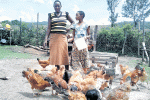Sue Auma
Author

The farm is situated at a farm in Olala village, Narok South. The village is 900 meters off the Mulot-Sogoo road. It is dotted with many Kipsigis traditional grass-thatched houses.
We are welcomed at Mrs. Lilian Cherono’s quarter-acre chain-link fenced compound, by the sounds of a chicken. She keeps 300 cross-bred kienyeji chicken, 20 mature cockerels and 30 chicks. “I had 200 chicks but a client bought 170 today. Another customer will come for the remaining tomorrow,” she says. She prefers free range chicken, though young chicks are kept in a cage to prevent attacks from predators such as hawks.“They were about 600 in January but I have since sold most of them,” she says.
She tried keeping broilers but abandoned the project due to lack of market and the high cost of feeds. She switched to rearing indigenous chickens late last year with 70 chicks. This was after she attended a one-day poultry farming training session at Kaki Village Enterprise in Gitaru, Kikuyu. It was here that she was introduced to Kenbro and Dorep breeds of chicken.
“Kenbro and Dorep are highly resistant to disease and mature faster. Their productivity in terms of eggs and meat quality is outstanding,” she says.To start off, she bought several indigenous chickens from the local market.
She sourced the Kenbro and Dorep chicken from Membley estate, Ruiru through a referral by one of her friends. She started cross-breeding the local chicken with Kenbro and Dorep cockerels.
The result is chicken with more weight when mature and which grow faster than the kienyeji ones. The chicks are hatched naturally, on old and tattered clothes in cartons.
REPLACE THE HATCHED EGGS
“The old clothes maintain constant warmth to the eggs. I regularly disinfect the cartons to keep away mites and lice,” she says. She selects eggs that are not more than 10 days old for hatching and puts 10 to 12 in each carton, depending on the body size of the hen.
So what is the secret behind her success? “Immediately the chicks are hatched, I replace the hatched eggs with fresh ones. I allow the chicks a few minutes to acclimatize before I take them from the mother hens and place them in an improvised brooder.
This way, the hens continue lying on the eggs. They can hatch a second time as long as they are fed properly,” Lilian says.
The crossbreed chicken is a dual purpose breed which has all the characteristics of the indigenous chicken but with the additional advantage of laying more eggs. It matures faster and fetches more money on the market.
She says poultry farmers should vaccinate the chicken to keep diseases at bay. Lilian feeds her chicken sunflower seeds, rastrineobola argentea, popularly known as omena, maize germ, sukuma wiki, green grass, and kitchen waste. She also crushes eggshells, which contain calcium, and feeds it to the chicken.
“I also grind garlic, onions and aloe vera leaves, I mixed it with water and put it in the chickens’ drinkers. This prevents worm infestation and boosts their immunity.” This, though, has not to be proved scientifically.
Eggs from the Kenbro, Dorep and the crossbreed chickens are on high demand with one selling for between Sh20 and Sh30. She is overwhelmed by the demand of the chicks and eggs.
From the proceeds of this venture, she is able to educate her son, who is at a high cost private secondary school in Nakuru County. “I get more than what I used to earn from the sale of maize,” says Lilian. “I quit farming maize this year. My target is to rear 1,500 chicken before the end of this year,” she says.
Article source - Biznakenya
Last edited by a moderator:
